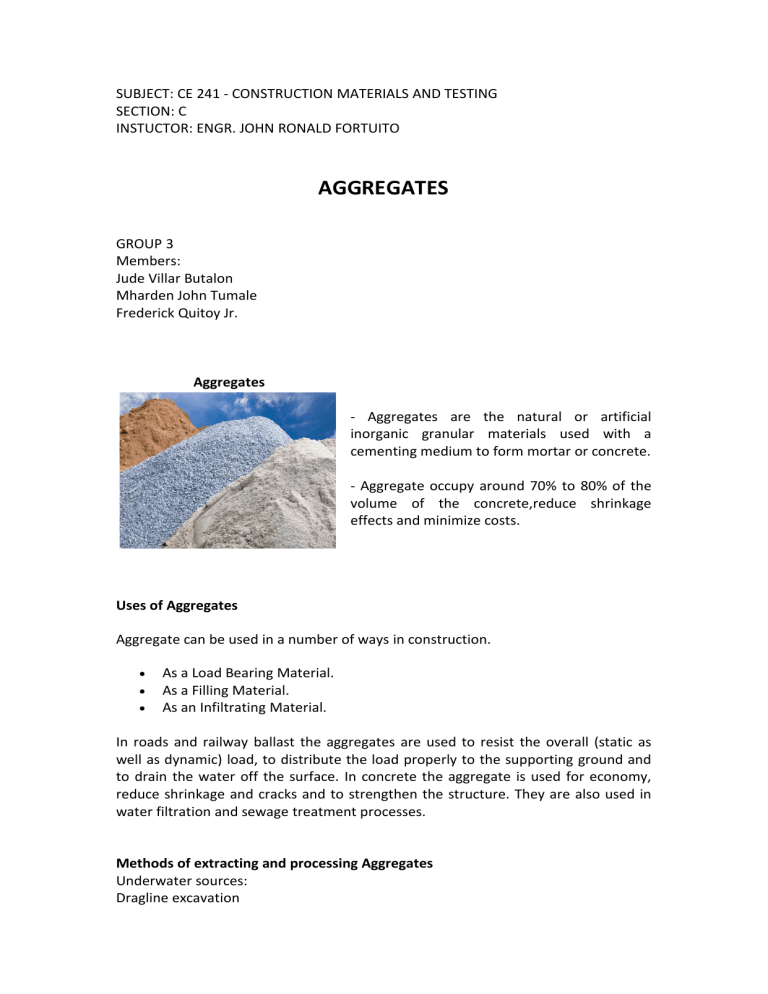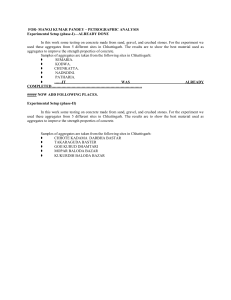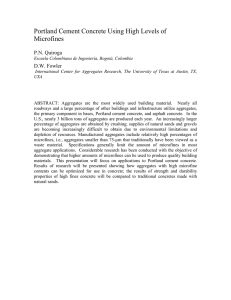
SUBJECT: CE 241 - CONSTRUCTION MATERIALS AND TESTING SECTION: C INSTUCTOR: ENGR. JOHN RONALD FORTUITO AGGREGATES GROUP 3 Members: Jude Villar Butalon Mharden John Tumale Frederick Quitoy Jr. Aggregates - Aggregates are the natural or artificial inorganic granular materials used with a cementing medium to form mortar or concrete. - Aggregate occupy around 70% to 80% of the volume of the concrete,reduce shrinkage effects and minimize costs. Uses of Aggregates Aggregate can be used in a number of ways in construction. As a Load Bearing Material. As a Filling Material. As an Infiltrating Material. In roads and railway ballast the aggregates are used to resist the overall (static as well as dynamic) load, to distribute the load properly to the supporting ground and to drain the water off the surface. In concrete the aggregate is used for economy, reduce shrinkage and cracks and to strengthen the structure. They are also used in water filtration and sewage treatment processes. Methods of extracting and processing Aggregates Underwater sources: Dragline excavation Dredging Land Sources: Blasting bedrocks Track Drills Crushers and Screens Good Qualities of an ideal Aggregates An ideal aggregate used for the manufacturing of concrete and mortar, should meet the following requirements: - It should consists natural stones,gravels and sand or in various combinations of these materials. - It should be hard, strong and durable. - It should be dense, clear and free from any coating. - It should be free from injurious vegetable matters. - It should not contain flaky (angular) and elongated pieces. - It should not contain any material liable to attack steel reinforcement in case of reinforced concrete. Classification of Aggregates Classification Based on Source Natural Aggregates - are taken from native deposits with no change in their natural state during production other than crushing, grading, or washing Examples: sand, gravel, crushed stone, pumice Artificial Aggregates - are those materials obtained either as a by-product of an unrelated industrial process or by a special manufacturing process like heat treatment. Examples: blast-furnace slag, expanded perlite, expanded vermiculite, burned clay Classification Based on Shapes 1. Rounded Aggregates - Are naturally rounded aggregates that are formed by water or weathering - Need less cement paste to make concrete - Interlocking between particles is poor - Not suitable for high strength concrete 2. Irregular Aggregates - Partly shaped aggregates are called irregular aggregates - No specific shape 3. Angular Aggregates - These aggregates have sharp edges and rough surfaces. - All types of crushed rocks are good examples for this type of aggregates - They need more cement paste, since voids are more in the aggregates - Ideal for producing high strength concrete 4. Flaky aggregates - Flaky aggregates have thickness less than 0.6 times mean sieve size to which particles belong. - Flaky aggregates reduce the durability of concrete 5. Elongated Aggregates - Individual particles are longer than they are wider or deeper and due to this appear to be long and thin. - This particle-type provides more surface area to a concrete mix Classification Based on Size - Fine Aggregates - Coarse Aggregates Fine Aggregates Aggregates passing through IS 4.75mm sieve Fine aggregates are basically natural sand particles from the land through the mining process, the fine aggregates consist of natural sand or any crushed stone particles that are ¼” or smaller. Examples: (a) Natural Sand Fine aggregates formed by natural disintegration of rocks (b) Crushed Stone Sand Fine aggregates made by crushing natural gravels (c) Broken Fine Aggregates Obtained by crushing broken brick (Surkhi) Qualities of Fine Aggregates -Fine aggregate should be clean i.e. it should be free from lumps, organic material, etc. -It should be strong and durable. -It should not react with cement after mixing. -Also, it should have a tough floor. -It should not absorb greater than 5% of water. -These types of aggregates should not be soft and porous. Properties of Fine Aggregates 1. Size of fine aggregates -The largest size that falls under the limit of the exact set is 4.75 mm. -Using the largest size will give more dense concrete, but a mixture of all sizes is more desirable and more economical. -If cement mortar is prepared for masonry work or plastering work, very fine types of sand of similar size is used. 2. Strength -The strength of the aggregate cannot ensure the strength of the concrete. The strength of coarse aggregates are more important. 3. Shape of Fine Aggregates -Irregularly nodular shaped sand is preferable to completely round grained sand. -The shape of the aggregate plays a more important role in the coarse aggregate than in the fine aggregate. 4. Specific Gravity -The specific gravity of aggregates is the ratio of the density of water to its density. -It is used for concrete mix design and if not specified the specific gravity is taken as 2.7 because the specific gravity of most aggregates obtained from different sources falls between 2.6 and 2.8. 5. Surface Texture of Fine Aggregates -Generally, round surface aggregates are better for smooth aggregates, this property is also related to coarse aggregate. 6. Water Absorption -Typically, for sand, water absorption is negligible, it is desirable that water absorption should be kept to a minimum. 7. Surface Index of fine aggregates: -It is an empirical number that corresponds to a specific surface of overweight particles given finer fractions. 8. Soundness -It refers to the expansion and contraction of aggregate when subjected to temperature changes. -A good, sound aggregates is one that exhibits minimal expansion or contraction under changing temperatures. 9. Surface Moisture -Many aggregates have a tendency to attract moisture that is adsorbed around each particle and gives rise to the bulking phenomenon. 10. Specific Surface of Fine Aggregates -The surface area per unit weight of the material is called a specific surface. 11. Bulking -Bulking is a phenomenon that causes the aggregates to swell by absorbing moisture from the humid air. -The concrete mix design may be inaccurate and enough additional sand is always added to compensate for this swelling when this bulk sand will return to normal state. 12. Bulk Density -It refers to the amount of voids or spaces between particles, as well as the total density of aggregates considered. -The unit weight of sand is between 17 and 25 kNIm3. Fine Aggregate Grading Sieve Sieve Size Percent Passing 3/8 in 9.5 mm 100 No.4 4.75 mm 95-100 No.8 2.36 mm 80-100 No.16 1.18 mm 50-85 No.30 600µm 25-60 No.50 300µm 5-30 No.100 150µm 0-10 No.200 75µm 0-3 FINENESS MODULUS (FM) - Obtained by adding the sum of the cumulative percentages by mass of a sample aggregate retained on each of a specified series of sieves and dividing the sum by 100. FM = sum of cumulative percent retained/100 Calculation of Fineness Modulus of Sand Let us say the dry weight of sample = 1000g. After sieve analysis the values appeared are tabulated below. Sieve Size Weight ret ained(g) Cumulated weight retained (g) Cumulative Percentage weight retained (%) 4.75 mm 0 0 0 2.36 mm 100 100 10 1.18 mm 250 350 35 0.6 mm 350 700 70 0.3 mm 200 900 90 0.15 mm 100 1000 100 Total 275 Therefore, fineness modulus of aggregate = (cumulative % retained) / 100 = (275/100) = 2.75 Coarse Aggregates The aggregates which is retained on IS 4.75mm sieve Most commonly used coarse aggregates are crushed stone, gravel, broken pieces of burnt bricks, etc. Coarse Aggregate Grading Sieve Sieve Size Percent Passing 1 ½ in 37.5 mm 100 1 in 25 mm 95-100 ½ in 12.5 mm 25-60 No. 4 4.75 mm 0-10 No.8 2.36 mm 0-5 SIEVE ANALYSIS OF AGGREGATES - It is a process of dividing a sample of aggregate into various fractions, each consisting of particles of same nominal size. The resultant of particle size distribution is called the gradation. Gradation 1. Well graded Well-graded aggregates have a gradation of particle size that fairly evenly spans the size from the finest to the coarsest. A core of well-graded aggregate concrete shoes a packed field of many different particle sizes. 2. Poor Graded This aggregate is characterized by a small variation in size. It includes aggregate particles that are near the same size. This means that the particles of the aggregate pack together, leaving relatively large voids in the concrete. 3. Gap Graded Gap-graded aggregate consists of aggregate particles in which some intermediate-size particles are missing. A core of gap-graded concrete shows a field of small-seized aggregate interspersed with slightly large aggregate pieces embedded in a small sized aggregate. Aggregate Property Test to be Conducted Strength Crushing Strength Test Hardness Abrasion Test Impact Value Impact test Resistance against weathering Soundness Test Shape of Aggregate Shape Test Bitumen Adhesion Bitumen Adhesion Test Specific Gravity/Relative Density Specific Gravity Test Water Absorption Water Absorption Test CRUSHING STRENGTH TEST ON AGGREGATES - The aggregate crushing value gives the crushing strength of aggregate up to which it can bear the load without fail. ABRASION TEST ON AGGREGATES - Hardness property of aggregate is determined by conducting abrasion test. Los Angeles abrasion testing machine is used to conduct this test. IMPACT TEST ON AGGREGATES - Impact value of aggregate will give aggregate capability against sudden loads of forces. SOUNDNESS TEST ON AGGREGATES - To determine the weathering resistance of aggregate, soundness test is conducted. If the resistance against weathering is good for aggregate, then it will have high durability. SHAPE TEST ON AGGREGATES - Shape of aggregate is also important consideration for the construction of pavement. Aggregate should not contain flaky and elongated particles in it. If they contain this type of of particles, they will affect the stability of mix. BITUMEN ADHESION TEST ON AGGREGATES - Bitumen adhesion test will give the stripping of bitumen from the aggregate. SPECIFIC GRAVITY TEST ON AGGREGATES - Specific gravity of an aggregate is the ratio of its mass to that of an equal volume of distilled water at specific temperature. WATER ABSORPTION TEST ON AGGREGATES - This test helps to determine the water absorption value of aggregate.


